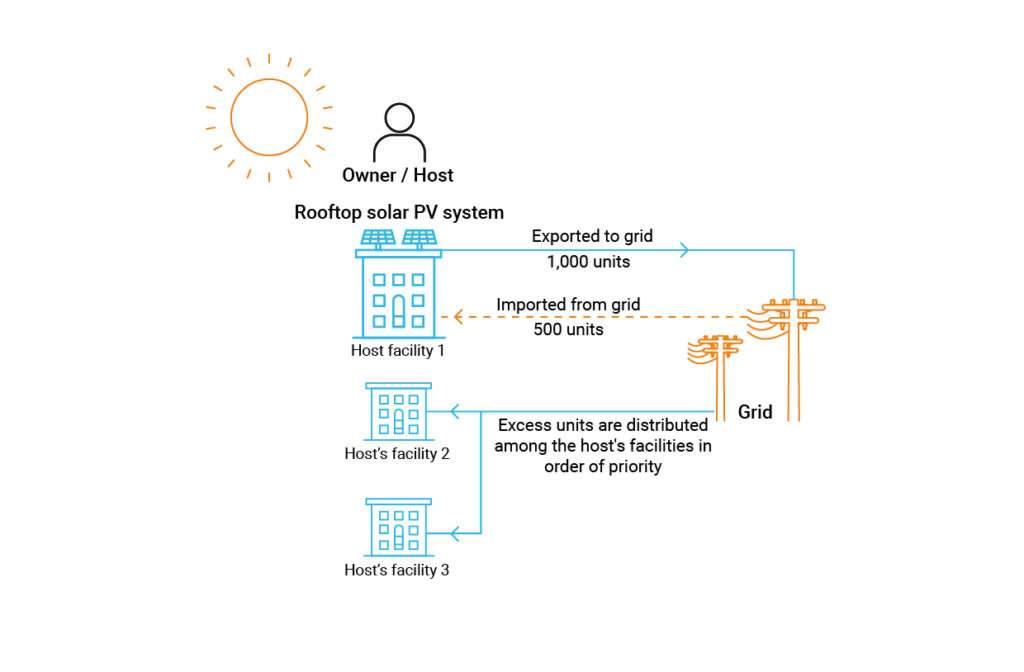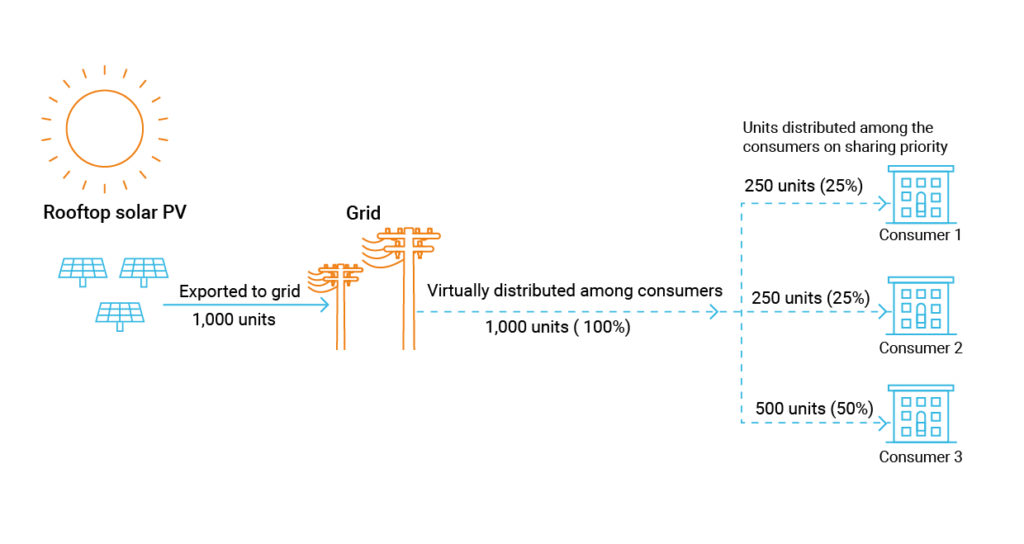The Future of Rooftop Solar Is Collective
How can homeowners without rooftops join the solar movement?
Rooftop solar is considered an option primarily for individual homeowners looking to switch to renewable energy. However, in urban India—where the majority of people reside in apartments, shared buildings, or rental properties—limited access to rooftop space has been a significant barrier. Now, innovations like Group Net Metering (GNM) and Virtual Net Metering (VNM) are transforming this landscape by making shared solar solutions accessible to more residents.
In the sections that follow, we’ll break down how these metering mechanisms work, where they’re available in India, and how they can be implemented by residential consumers.
What are Group Net Metering and Virtual Net Metering?
To share generated solar energy across multiple homes or electricity meters, it must first be measured and credited accurately. This process of energy accounting ensures fair distribution of benefits and transparent billing.
That’s where Group Net Metering (GNM) and Virtual Net Metering (VNM) come in. These mechanisms create a framework for sharing or allocating rooftop solar energy across multiple electricity connections, making it possible to benefit from solar power even when generation and consumption don’t happen at the same point.
Group Net Metering (GNM):
Rooftop solar generation can now be distributed among connections using mechanisms like GNM. However, the extent to which this sharing is possible depends on specific policies—particularly, whether all participants are connected to the same DISCOM or different DISCOMs.
For instance, a homeowner may install a solar plant on the rooftop of one property and use the excess energy to offset the electricity bills of other properties they own—such as another residence, a home office, or even common area loads in an apartment building.
Key features of GNM:
- All linked electricity connections must be owned by the same person or legal entity.
- The solar plant and all linked connections must be located within the same DISCOM area.
- Surplus energy generation from the solar plant is first adjusted at the primary site; any remaining units are credited to other linked meters.
- Units can be distributed among meters based on predefined ratios—such as equally, proportionally to consumption, or as specified by the consumer (subject to DISCOM approval).
- In many states, regulations require that only consumers served by the same distribution company (DISCOM) can participate in the mechanism.
Figure 1 – Representative schematic for Group Net Metering

GNM is particularly useful for:
- Building owners with separate meters for residential units and common services like elevators or lighting.
- Individuals or families with multiple residences within a city or township.
Virtual Net Metering (VNM):
Virtual Net Metering allows consumers to benefit from a solar installation located off-site—such as on a shared rooftop, open land, or another building they don’t occupy—by virtually allocating the energy credits to their electricity connection.This model is especially useful for consumers who do not have any rooftop access or suitable conditions for solar installation, such as apartment residents or tenants.
Community solar is a common variant of VNM, allowing multiple consumers to collectively participate in and benefit from a shared solar project.
Key features of VNM
- The solar plant and the consumer’s electricity connection can be at different locations within the same DISCOM.
- Supports collective or group ownership models, such as by a housing society or cooperative.
- Energy generated is virtually credited to participating consumers’ electricity bills.
- Units are allocated to beneficiaries based on a pre-agreed share—often linked to ownership stake or monthly consumption—and recorded by the DISCOM for billing.
- In many states, regulations require that only consumers served by the same distribution company (DISCOM) can participate in the mechanism.
Figure 2 – Representative schematic for Virtual Net Metering

VNM is ideal for:
- Apartment complexes where the rooftop is shared by many residents.
- Tenants or residents without rooftop access.
- Community-based solar projects or cooperative models
Policy Landscape: Where are GNM and VNM allowed?
While rooftop solar is gaining traction across India, Group Net Metering and Virtual Net Metering are only available in select states and Union Territories. As of now, 18 states and UTs have formally adopted GNM and/or VNM in their regulations.
Let’s look at two key examples where both GNM and VNM are operational and clearly defined: Puducherry and Delhi.
Puducherry:
Puducherry’s Solar Energy Policy (2015) was one of the first in India to introduce both GNM and VNM. The policy extended the benefits of rooftop solar power to consumers living in apartments, institutions, and public buildings without access to suitable rooftop spaces. The mechanisms were incorporated in Puducherry’s regulatory framework.
- GNM in Puducherry allows consumers to offset consumption across multiple connections they own.
- VNM is targeted at domestic consumers, residents of group housing, educational campuses, and public buildings, allowing them to share a single rooftop system and allocate units virtually.
Case study: Residential Group Net Metering, Puducherry
A house owner installed a 2.1kWp rooftop solar system in 2019 on their roof. The energy generated from the system was able to meet more than 100% of the requirement during the winter season. During this season, the system produced excess rooftop solar energy, which was not completely absorbed by the house. The house owner made a decision to adopt GNM and include another residential connection under this scheme to absorb the excess electricity generated from the rooftop solar system. The excess generation during winter was able to significantly reduce the second residence’s electricity bill. In summer, however, due to the usage of Air Conditioner units, only the primary residence sees bill savings as the installed rooftop solar capacity generates less than what is consumed within that billing cycle.
Delhi:
Delhi institutionalized both GNM and VNM through Delhi Electricity Regulatory Commission’s (DERC) guidelines in 2019, offering a clear path to implementation.
- GNM enables surplus energy from one rooftop system to be credited to other electricity meters owned by the same individual or legal entity, within the same DISCOM.
- VNM is intended for housing societies and institutions that share a rooftop system and receive proportionate energy credits.
Case Study: Milan Vihar Apartments, Delhi
Milan Vihar CGHS, a cooperative housing society in East Delhi, installed a shared rooftop solar plant under the Virtual Net Metering framework.
Key outcomes
- Solar credits are distributed among 96 individual flats using a predefined sharing arrangement.
- Residents benefit from reduced electricity bills despite not having individual solar systems.
- The model has become a reference case for other group housing societies in Delhi.
Case Study: Virtual Net Metering Pilot for low-income households, Delhi
As part of a broader demonstration project, Bridge to India, a solar consulting firm, worked with BSES Yamuna Power Ltd., a Delhi based distribution company, to explore VNM for low-income housing clusters. The project showed that shared solar could benefit even economically weaker sections, as long as fair allocation and billing transparency were ensured.
Consumer Consideration:
A few key considerations should guide the decision-making process to ensure viability and long-term gains.Consumers must confirm whether GNM or VNM is operational in their state or Union Territory. These mechanisms are only available in select states, and the exact implementation can vary based on DISCOM-specific regulations. For example, there may be restrictions on the minimum or maximum size of the solar plant, or requirements regarding the number and type of connections that can be linked.While these mechanisms significantly lower electricity bills and make solar more accessible, financial viability varies depending on system size, applicable tariff categories, and whether energy credits can be carried over across billing cycles.
Conclusion:
GNM and VNM are transforming rooftop solar from an individual pursuit to a collective opportunity. With the right planning and coordination, these models can benefit not only homeowners but also tenants, industrial and commercial clusters and institutions. As more states refine their policies and streamline implementation, residential consumers across India will be better positioned to participate in the clean energy transition—regardless of roof ownership or access.
